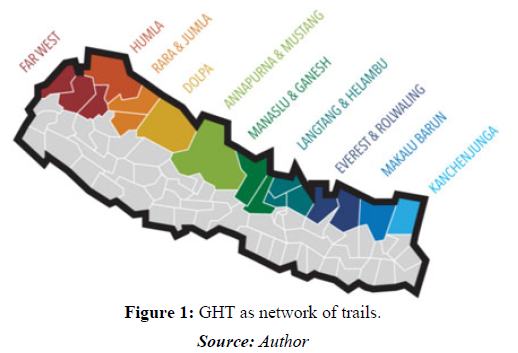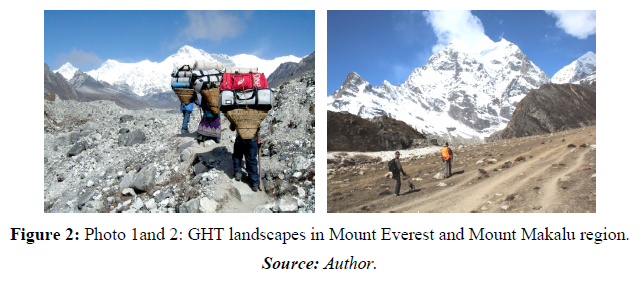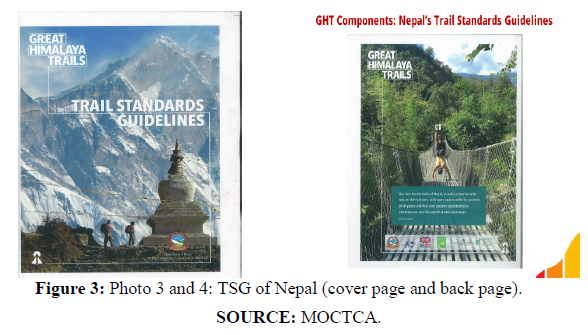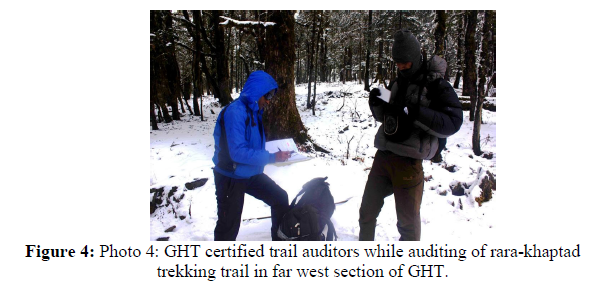Research Article
GREAT HIMALAYA TRAILS (GHT) BRAND FOR MOUNTAIN TOURISM: A CALL FOR POST-COVID DESTINATION SAFETY AND QUALITY ASSURANCE IN NEPAL
943
Views & Citations10
Likes & Shares
The Great Himalaya Trails (The GHT) form an extensive network of trails across the Nepal hills and mountains. The GHT comprises a Brand for mountain tourism identity which ensures quality, safety and standards. The quality of Nepal’s service deliveries of enterprises, physical destination facilities and trekking tourism infrastructures do not currently meet international expectations and creates an unsustainable shift towards a high-volume and low value model. It has necessitated for a paradigm shift towards the standardization and qualitative improvements through re-branding Nepal’s tourism offers. It necessitates that post-covid mountain tourism of Nepal reestablishes GHT as the quality brand. For it, Trail Standard Guidelines 2017 guided trail planning, building, managing, maintaining as well as grading of the trails and certification and accreditation of Nepal's mountain trails that go through an internationally accredited auditing process by the certified trail auditors is crucial.
Keywords: GHT, Mountain Tourism, Post-Covid, Destination Safety, Destination Quality
INTRODUCTION
Nepal offers an extensive network of trails as the “Great Himalaya Trails (The GHT)” in the hills and mountains distributed across 10 GHT sections that connect both lower and upper segments while expanding from Kanchanjunga in the East and Api-Saipal in the West including popular trekking destinations of Everest, Annapurna and Langtang. GHT is one of the World’s longest and highest walking trails. It covers the full distance of the Himalayan Mountain range in Nepal and continues through Tibet, India and Myanmar to the east of Nepal and through Tibet, India and Pakistan to the west. Within Nepal, the GHT is roughly divided into two main routes: the 1,700 km-long High Route, which winds through high mountain ranges with an average altitude of 3,000-5,000m; and the Low Route (also referred to as the Cultural Route), which wends its way 1,500 km through mid-hills between 1,500 and 2,500m. The two routes of the GHT in Nepal are fairly distinct from one another, but are interlinked and also have a number of side-treks. Overall, the GHT passes through all five development regions of Nepal, many of the country’s 77 districts and numerous towns and villages, large and small (Choegyal, 2011; GHTNA, 2018; Upadhayaya, 2018).
METHODOLOGY
The author has applied eclectic technique for accumulating information from his work experience as the GHT certified trail auditor and Nepal government approved trek guide. The methodology included the collection of the qualitative information through primary source of information from the research based GHT trails auditing in the years 2016 and 2017. The secondary source of information included a comprehensive review of relevant published and unpublished literatures, reports and data through desk studies.
RESULTS DISCUSSION
GHT has the potential to be established as an emerging brand for mountain tourism identity of Nepal that represents the trekking sub-sector as the flagship product.


Normally, visitors use the GHT as part of organized treks or tours comprising from just a couple of individuals to large groups. Most of these treks which also uses the products and services of ranges of enterprises (e.g., tea houses, lodges, homestay, F & B outlets, tea shops, etc.) are arranged through the more than 3000 tour/trekking companies currently registered in Nepal. The products and services that exist and operate along the GHT through tour/trek companies and tourist accommodations on GHT play a crucial and increasingly important role in the functioning of the country’s economy. The GHT is generally recognized around the world as an outdoor trail of some significance and quality and is frequently viewed and presented as being one of the world’s leading trails (SNV Nepal 2014).

The enormous Great Himalaya Trails can provide opportunities for each visitor to experience the network of extra ordinary journeys (natural and cultural diversified and religiously and spiritually unique that Nepal offers) through developing and marketing trails as quality and safety assured products (ensured standards on trails maintenance and development that meet international best practice) to the global market of tourism. Thus, GHT has potential to be established as a quality ‘brand’. Also, there is a high level of interest shown in the GHT by established tour/trekking operators, ecotourism product owners and emerging entrepreneurs at national and local levels in using the GHT ‘brand’ and including and even marketing and promoting their products as part of the GHT (MoCTCA, 2017).
The existing reputation and the potential high image of GHT, however, often doesn’t really match the situation on the ground, especially with regard to the services offered by tour operators who sale GHT and accommodation service providers that exist along the trail. Thus, the quality of Nepal’s service deliveries of enterprises, physical destination facilities and trekking tourism infrastructures do not currently meet international expectations and creates an unsustainable shift towards a high-volume and low value model. It has necessitated for a paradigm shift towards the safety, standardization and qualitative improvements through re-branding Nepal’s tourism offers. This is unavoidably applicable in the era and aftermath of Corona Virus Disease-19 (COVID-19) that started from Wuhan, China since December 2019. The COVID induced health hazard (catastrophe) has compelled for immediate and indefinite halt on international tourism and called for post-COVID destination safety and quality assurance in tourism including Nepal's GHT too. The selective nature of the effects of COVID-19 and the measures to contain it may lead to reorientation of tourism in some cases. In this context, there is growing attention as how differently adventure tourism will restore with desired safety, quality and standards in Nepal.
Earlier on 30 May 2017, Nepal Tourism Board, the national tourist organization had positioned itself as the custodian of GHT after signing a MoU between Nepal Tourism Board (NTB) and SAMARTH- Nepal Market Development Programme (UK-Aid subsidiary). It allowed to handover GHT from UK-Aid to NTB. The GHT Management Unit consisting a pool of certified trail auditors has been in operation at NTB since June 2017. The GHT Management unit has taken the Standard Operating Procedure and Business Plan as the guiding framework to design, execute and accelerate its activities aimed for adding value to GHT brand.
For establishing GHT as the quality brand, the sustainable trail planning and management is the prerequisite and this is necessitated as an integral part of GHT brand image which has a number of brand promises like (i) Trail Standard Guidelines 2017 guided trail planning, building, managing, maintaining as well as grading of the trails; and (ii) Certified and accredited trails that go through an internationally accredited auditing process by the certified trail auditors; and (iii) Carefully selected tour operators who sale GHT by attracting high volume with higher paying tourists whose more money into the economy is beneficial for service providers (entrepreneurs and workers). Based on aforesaid conceptual foundations, the "Trail Standards Guidelines (TSG)" was launched by the Ministry of Culture, Tourism and Civil Aviation (MoCTCA) in February 2017 for standardizing and grading trails across the country.


The guidelines is designed as a summary for easy reference for the planning, construction, management and maintenance to the basic trail types and trail standards to be found in Nepal. It is a guideline of best practices and internationally accepted standards for trails as applied to Nepal’s unique geography and terrain challenges in relation to trail design (MoCTCA, 2017).
Trail Standards Committee led by MoCTCA, private sectors (Trekking Agencies’ Association of Nepal), Nepal Tourism Board, SAMARTH-NMDP, World Trails Network, and Green Flag Trails International had developed Trail Standards Guidelines. Alongside, for the first time in its trail history, Nepal also developed 11 internationally certified trail auditors who are licensed to audit trails and grade them as per the trail standards set in the guidelines.
Building on these achievements, NTB has been formulating its annual budget and plan of actions on GHT consisting of GHT trails and GHT brand promotion for the fiscal year 2017-18. Such activities include auditing trails scattered in varied sections of GHT from east to west, post-auditing safe and standard infrastructures (e.g. hand railings, slippery pathway maintenance, warning signage, resting shades, water outlets on pathway, etc.) buildings, standardization of trails and their final accreditations, conducting a number of training and workshops on trial regions, institutionalization of GHT unit office and its networking, enhancement of the safety (food safety including minimum level of hygiene and sanitation), quality and standards of lodges and their certifications, and promotion of accredited GHT trails in global adventure tourist markets.


It is envisioned that designing these interventions to address various constraints at GHT would contribute to a substantive growth in the trekking sub-sector and will in turn create numerous income opportunities for unskilled men and women.
To strengthen the management and performance of GHT Management Unit and drive the GHT quality brand in a coordinated way through the representations of important key stakeholders that can ensure a sustained tourism system, NTB also constituted a nine-member GHT Advisory Committee. The long-lasting success of sustainable trail planning and management rests on the implementations of the trail standards in Nepal through the collaboration and integrated approach between all stakeholders (public, private sector, trail communities and development partners).
CONCLUSION
The GHT comprises a Brand and an Organizational Entity. The brand registers trails and enterprises that adhere to GHT guidelines on Safe Trekking, quality, environmental impact standards as well as social objectives that ensure fair working conditions and wages and respect all indigenous cultures regardless of case and gender. As called by the era of COVID-19, the GHT stays true to the authentic appeal of Nepal's tourism attractions but enhances these through quality adaptation that ensures a sustained and beneficial tourism system able to attract increasing visitors from diverse source markets.
- Choegyal, L. (2011). The Great Himalaya Trail: A New Nepal Tourism Product with Both Trek Marketing and Development Rationale. Nepal Tourism & Development Review 1(1), 71-76.
- GHTNA. (2018). History of the Great Himalaya Trails. Available from the website of the Great Himalaya Trail (Nepal) Alliance website http://ghtnepalalliance.org/history-of-the-ght/
- MoCTCA. (2017). Great Himalaya Trails Trail Standards Guidelines. Kathmandu: MoCTCA with technical assistance from SAMARTH-NMDP funded by DFID.
- SNV Nepal. (2014). The Great Himalaya Trail Guide Book & Blog Great Himalaya Trail Low Route. Kathmandu: Great Himalaya Trail Development Programme and Himalayan Map House (P.) Ltd.
- Upadhayaya, P.K. (2018). Nepal’s Great Himalaya Trails A Quality Brand for Mountain Tourism. In Itineraries International Travel Magazine Issue 1 Jan-Feb 2018, 10-11. Kathmandu: Itineraries Media Pvt. Ltd.
- Upadhayaya, P. K. (2018). Sustainable Management of Trekking Trails for the Adventure Tourism in Mountains: A Study of Nepal’s Great Himalaya Trails. Journal of Tourism & Adventure 1(1), 1-31.





